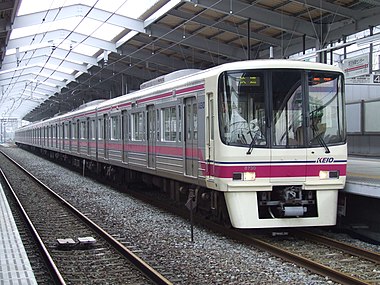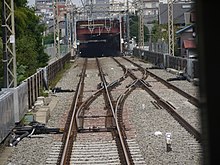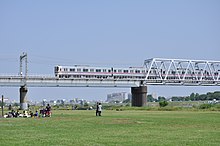Keiō Sagamihara lineage
| Keiō Sagamihara lineage | |||||||||||||||||||||||||||||||||||||||||||||||||||||||||||||||||||||||||||||||||||||||||||||||||||||||||||||||||||||||||||||||||||||||||||||||||||||||||||||
|---|---|---|---|---|---|---|---|---|---|---|---|---|---|---|---|---|---|---|---|---|---|---|---|---|---|---|---|---|---|---|---|---|---|---|---|---|---|---|---|---|---|---|---|---|---|---|---|---|---|---|---|---|---|---|---|---|---|---|---|---|---|---|---|---|---|---|---|---|---|---|---|---|---|---|---|---|---|---|---|---|---|---|---|---|---|---|---|---|---|---|---|---|---|---|---|---|---|---|---|---|---|---|---|---|---|---|---|---|---|---|---|---|---|---|---|---|---|---|---|---|---|---|---|---|---|---|---|---|---|---|---|---|---|---|---|---|---|---|---|---|---|---|---|---|---|---|---|---|---|---|---|---|---|---|---|---|---|
|
Class 8000 multiple unit in the Tama-Center station
| |||||||||||||||||||||||||||||||||||||||||||||||||||||||||||||||||||||||||||||||||||||||||||||||||||||||||||||||||||||||||||||||||||||||||||||||||||||||||||||
| Route length: | 22.6 km | ||||||||||||||||||||||||||||||||||||||||||||||||||||||||||||||||||||||||||||||||||||||||||||||||||||||||||||||||||||||||||||||||||||||||||||||||||||||||||||
| Gauge : | 1372 mm ( Scottish gauge ) | ||||||||||||||||||||||||||||||||||||||||||||||||||||||||||||||||||||||||||||||||||||||||||||||||||||||||||||||||||||||||||||||||||||||||||||||||||||||||||||
| Power system : | 1500 V = | ||||||||||||||||||||||||||||||||||||||||||||||||||||||||||||||||||||||||||||||||||||||||||||||||||||||||||||||||||||||||||||||||||||||||||||||||||||||||||||
| Top speed: | 110 km / h | ||||||||||||||||||||||||||||||||||||||||||||||||||||||||||||||||||||||||||||||||||||||||||||||||||||||||||||||||||||||||||||||||||||||||||||||||||||||||||||
| Dual track : | whole route | ||||||||||||||||||||||||||||||||||||||||||||||||||||||||||||||||||||||||||||||||||||||||||||||||||||||||||||||||||||||||||||||||||||||||||||||||||||||||||||
| Society: | Keiō Dentetsu | ||||||||||||||||||||||||||||||||||||||||||||||||||||||||||||||||||||||||||||||||||||||||||||||||||||||||||||||||||||||||||||||||||||||||||||||||||||||||||||
|
|||||||||||||||||||||||||||||||||||||||||||||||||||||||||||||||||||||||||||||||||||||||||||||||||||||||||||||||||||||||||||||||||||||||||||||||||||||||||||||
The Keiō Sagamihara Line ( Japanese 京 王相 模 原 線 , Keiō Sagamihara-sen ) is a railway line on the Japanese island of Honshū , which is operated by the Keiō Dentetsu railway company . It is a branch of the Keio Line and connects Chofu in Tokyo Prefecture with Sagamihara in Kanagawa Prefecture . Its main purpose is the development of the Tama New Town , a planned city in the Tama hill country .
Route description
The 22.6 km long, double-track line is electrified with 1500 V DC . It serves twelve train stations and has a top speed of 110 km / h. Like the vast majority of the lines from Keiō Dentetsu, it has the unusual gauge of 1372 mm (so-called "Scottish gauge"). The prefectural border is crossed a total of five times.
The eastern starting point is the underground Chōfu station , where the line branches off from the Keiō line to the south. The tunnel ends after just under a kilometer and immediately merges into a dam that crosses the broad river plain of the Tama . After crossing the river, the route gradually turns west again. At Keiō-Yomiuri-Land station there is a connection to the Sky Shuttle , a gondola to the Yomiuriland amusement park . Then the Tama Hills are reached and the route gradually climbs, following the Misawa Valley.
The route then opens up Tama New Town , a planned town with more than 200,000 inhabitants that was created between the 1960s and 1980s . Immediately at the station Wakabadai is one of the depots of the Keio Dentetsu. At the 1st Wakadabai tunnel, a section around three and a half kilometers long begins, which runs in the Kotta Valley parallel to the tracks of the Odakyū Tama line of the Odakyū Dentetsu railway company . There is no track connection due to different gauges. The parallel tour ends in the Tama-Center station , the center of the settlement, where you can change to the Tama monorail . It continues in hilly terrain, always slightly uphill, under a golf course and through the 809 meter long Minami Ōsawa tunnel. Eventually the route reaches the Hashimoto in the center of Sagamihara.
Trains
The supply of trains on the Keiō Sagamihara line is very dense. All trains run from Shinjuku in central Tokyo via Chofu to Hashimoto and back. You almost never have to change trains in Chofu. Shinjuku is one hand, the city-side terminal, on the other hand, are there numerous trains via New Keio line to Toei Shinjuku Line of the Tokyo subway by bound . Six to nine trains per hour are offered during the day, and up to twelve trains per hour during rush hour. In addition to the usual local trains, there are six types of express and express trains that stop at different numbers of intermediate stations. Below is an overview:
■ Keio Liner ( 京 王 ラ イ ナ ー )
The Keio Liner introduced in February 2018 are geared towards the needs of long-distance passengers . They are the only trains for which a supplement is required, combined with a seat reservation. From Shinjuku they run every hour on weekdays from 8:00 p.m., from Hashimoto back to Shinjuku from 5:20 p.m. On the way they only stop in Keiō-Nagayama, Tama-Center and Minami-Ōsawa.
Additionally stop in Keiō-Inadazutsumi (as well as from Chōfu at different train stations):
■ Tokkyū ( 特急 , English Special Express )
■ Juntokkyū ( 準 特急 , English Semi Special Express )
■ Kyūkō ( 急 行 , English Semi Special Express )
Stop at all train stations between Hashimoto and Chōfu (as well as from Chōfu at different train stations):
■ Kukan-kyūkō ( 区間 急 行 , English Semi Express )
■ Kaisoku ( 快速 , English Rapid )
■ Kakueki-teisha ( 各 駅 停車 , English Local )
history
Gravel transport and excursion traffic
The railway company Keiō Denki Kidō (today Keiō Dentetsu ) opened the first single-track section of the later Sagamihara line on June 1, 1916. It branched off at Chofu station and led 1.2 km to Tamagawara ( 多摩川 原 , called Keiō-Tamagawa since 1937 ) on the north bank of the Tama River . At that time, several so-called “gravel tracks” were built in the region to mine the gravel deposits along the river banks. The Great Kantō earthquake of 1923 destroyed numerous houses made of wood and brick. Since the new buildings were built from more resistant cement , the demand for the raw material gravel increased enormously. The damage to the river was so great that gravel mining on the Tama had to be stopped in 1964 and has been completely banned since 1965.
The gravel transport on the short Tamagawa branch line was so extensive that the railway company put a second track into operation on April 1, 1924. In order to stimulate passenger traffic, she opened the Keiō pavilion in front of Tamagawara station in 1927. At the time, it was considered one of the best amusement parks in the Tokyo region . From 1933 to 1936 there were also fireworks shows on the riverbank. With the outbreak of the Pacific War , the number of passengers decreased significantly and the area was temporarily used as a potato field. From 1954 there were again fireworks shows and in 1955 a new amusement park was opened at the previous location (in operation until 1971). In 1956 a small botanical garden was added, today's Keio Floral Garden ANGE . On August 4, 1963, the voltage of the overhead line was increased from 600 to 1500 V.
Development of the Tama New Town
After the government had implemented an ambitious development plan for the Tama hill country in 1958, which provided for the creation of extensive residential and industrial areas to relieve Tokyo, several communities around Sagamihara formed an interest group. This campaigned energetically at Keiō for the construction of a railway line. In 1963, the railway company submitted a license application for the extension of the Tamagawa branch line, which had existed for almost half a century. It was supposed to lead through the middle of Tama New Town , a planned town for more than 200,000 inhabitants that was still in the project stage at the time . The Odakyū Dentetsu also strove to open up the area. The Ministry of Transport carefully ensured that the planned routes from Keiō and Odakyū made as little competition as possible and awarded the concessions accordingly. Both companies agreed to run their routes in the center of Tama about three and a half kilometers in parallel in order to minimize land consumption.
Construction work on the extension began in 1968 and on April 1, 1971, the 2.7 km long section between Keiō-Tamagawa and Keiō-Yomiuri Land went into operation. On the same day, the Tamagawa branch line was renamed the Sagamihara Line. Further construction was delayed because the capacity on the subsequent Keio line to Shinjuku was not yet sufficient during rush hour. The new residents had to take a bus to the nearest existing train station for a while, which was quite inconvenient. Keiō also had liquidity problems, as the profits from property developments in other locations were insufficient to fully cover the construction costs. For the same reason, Odakyū also temporarily stopped work on the Tama line . Both companies then turned to the government for assistance.
In 1972 the government instructed the state-owned Japan Railway Construction Public Corporation (JRCPC) to also pre-finance the construction of new lines that did not belong to the Japanese State Railways . The private railways as operators then had 25 years to repay the infrastructure costs. On October 18, 1974, the section between Keiō-Yomiuri-Land and Tama-Center was put into operation . Half a year later the Tama line also reached there. In the first few years the number of travelers remained well below expectations. The reason for this was the oil price crisis of 1973, which led to a significant cooling of the overheated property market and thus to a temporary sharp drop in demand for new apartments.
Extension to Hashimoto
After overcoming the crisis, Tama New Town expanded further west, with the population exceeding 60,000 in 1980 and more than 100,000 in 1987. In 1983, therefore, plans began for the extension of the line to the existing Hashimoto station of the JR East railway company . Crossing the Fuchū Country Club golf course , where a tunnel portal was planned between the 13th and 14th hole, proved to be problematic . After tough negotiations, Keiō undertook to change the plan and relocate the tunnel portal. The golf club received compensation of 1.088 billion yen (more than double the original offer), on the one hand to finance the costly remodeling of the affected golf course section, on the other hand as compensation for the loss of earnings during the partial closure.
It was planned to put the entire line into operation in March 1987. However, delays in acquiring the property meant that the deadline could not be met. Several landowners near Hashimoto Station stubbornly refused to sell their parcels. Keiō was therefore forced to initiate expropriation proceedings. The section between Tama-Center and Minami-Ōsawa was opened on May 21, 1988, and on March 30, 1990 the rest of the route to Hashimoto was opened. In the following seven years, the number of passengers from Hashimoto doubled. The section between Chōfu and Keiō-Tamagawa was moved into a tunnel on August 19, 2012.
List of train stations
To = Tokkyū (Special Express); Ju = Juntokkyū (Semi Special Express); Ky = Kyūkō (express); KL = Keio Liner
| Surname | km | To | Ju | Ky | KL | Connecting lines | location | place | prefecture | |
|---|---|---|---|---|---|---|---|---|---|---|
| KO18 | Chōfu ( 調 布 ) | 0.0 | ● | ● | ● | ǀ | Keiō line | Coord. | Chofu | Tokyo |
| KO35 | Keiō-Tamagawa ( 京 王 多摩川 ) | 1.2 | ǀ | ǀ | ǀ | ǀ | Coord. | |||
| KO36 | Keiō-Inadazutsumi ( 京 王 稲 田 堤 ) | 2.5 | ● | ● | ● | ǀ | Coord. | Tama-ku , Kawasaki | Kanagawa | |
| KO37 | Keiō-Yomiuri Land ( 京 王 よ み う り ラ ン ド ) | 3.9 | ǀ | ǀ | ǀ | ǀ | Sky shuttle | Coord. | Inagi | Tokyo |
| KO38 | Inagi ( 稲 城 ) | 5.5 | ǀ | ǀ | ǀ | ǀ | Coord. | |||
| KO39 | Wakabadai ( 若 葉 台 ) | 8.8 | ǀ | ǀ | ǀ | ǀ | Coord. | Asao-ku , Kawasaki | Kanagawa | |
| KO40 | Keiō-Nagayama ( 京 王永 山 ) | 11.4 | ● | ● | ● | ● | Coord. | Tama | Tokyo | |
| KO41 | Tama Center ( 多 摩 セ ン タ ー ) | 13.7 | ● | ● | ● | ● |
Odakyū Tama Line Tama monorail |
Coord. | ||
| KO42 | Keiō-Horinouchi ( 京 王 堀 之 内 ) | 16.0 | ǀ | ǀ | ǀ | ǀ | Coord. | Hachiōji | ||
| KO43 | Minami-Ōsawa ( 南大 沢 ) | 18.2 | ● | ● | ● | ● | Coord. | |||
| KO44 | Tamasakai ( 多 摩 境 ) | 20.1 | ǀ | ǀ | ǀ | ǀ | Coord. | Machida | ||
| KO45 | Hashimoto ( 橋本 ) | 22.6 | ● | ● | ● | ● |
Sagami Line Yokohama Line |
Coord. | Sagamihara | Kanagawa |
Web links
- Keiō Dentetsu route network (PDF, 798 kB)
Individual evidence
- ↑ Weekday schedule to Shinjuku. Keiō Dentetsu , 2020, accessed April 7, 2020 (Japanese).
- ↑ 京 王 ラ イ ナ ー 2 月 22 日 発 進 座席 指定 一律 400 円. Sankei News, January 24, 2018, accessed April 7, 2020 (Japanese).
- ↑ 2 月 22 日 か ら 当 社 初 と な る 有 料 の 座席 指定 列車 「京 王 ラ イ ナ ー ー」 が 夜間 時間 帯 に 運行 開始! (PDF, 533 kB) Keiō Dentetsu , January 24, 2018, accessed April 7, 2020 (Japanese).
- ↑ 多摩川 の 砂 利 採掘. City of Inagi, June 28, 2017, accessed April 2, 2020 .
- ↑ 京 王 帝都 電 鉄 30 年 史 . Keiō Teito Dentetsu, Tama 1978.
- ↑ Sōichirō Sakai: 新編 ・ 多 摩 市 の 郷 土 史誌 (古代 〜 平 成 8 年) . Tama shiritsu toshokan shozō shiryō, Tama 2003.
- ↑ 小田急 五 十年 史 . Odakyū Dentetsu , Tokyo 1980, p. 489 .
- ↑ Yomiuri Shinbun , May 21, 1971.
- ↑ Keiō Dentetsu (Ed.): 京 王 ハ ン ド ブ ッ ク 2016 . (Keiō Handbook 2016). Tama 2016.
- ↑ Akira Hōjō: 多 摩 ニ ュ ー タ ウ ン 開 発 の 全貌 . Tama New Town rekishi kenkyūkai, Tama 2012, p. 116 .
- ↑ 多 摩 ニ ュ ー タ ウ ン の 人口 ・ 世 帯 数 の 推移 . In: 多 摩 ニ ュ ー タ ウ ン 開 発 事業 史 - 通史 編 . Urban Renaissance Agency, Tokyo 2006, p. 270 .
- ↑ Jun'ichi Kuramochi: 多 摩 ニ ュ ー タ ウ ン 建設 に と も な う 京 王相 模 原 線 敷設 問題 . Tama New Town gakkai, Tama 2007, p. 57-64 .
- ↑ Keiō Dentetsu (Ed.): 京 王 電 鉄 五 十年 史 . Tama 1998, p. 142 .
- ↑ Keiō Dentetsu (Ed.): 京 王 ハ ン ド ブ ッ ク 2016 . (Keiō Handbook 2016). Tama 2016.





